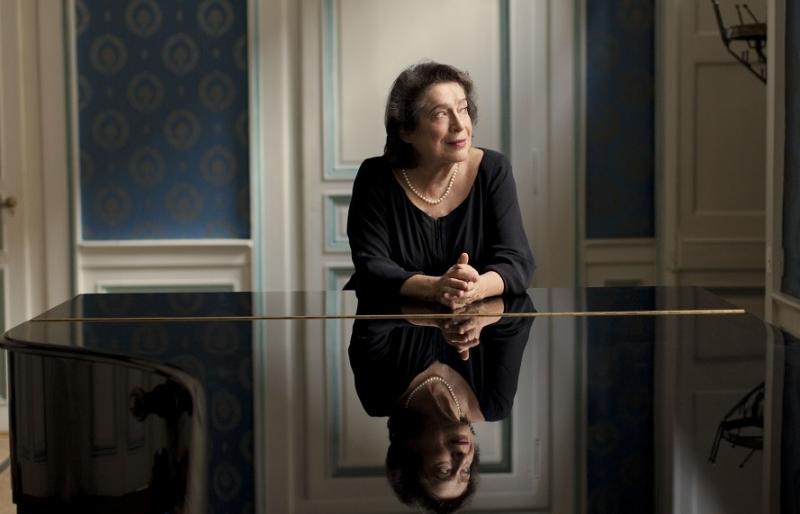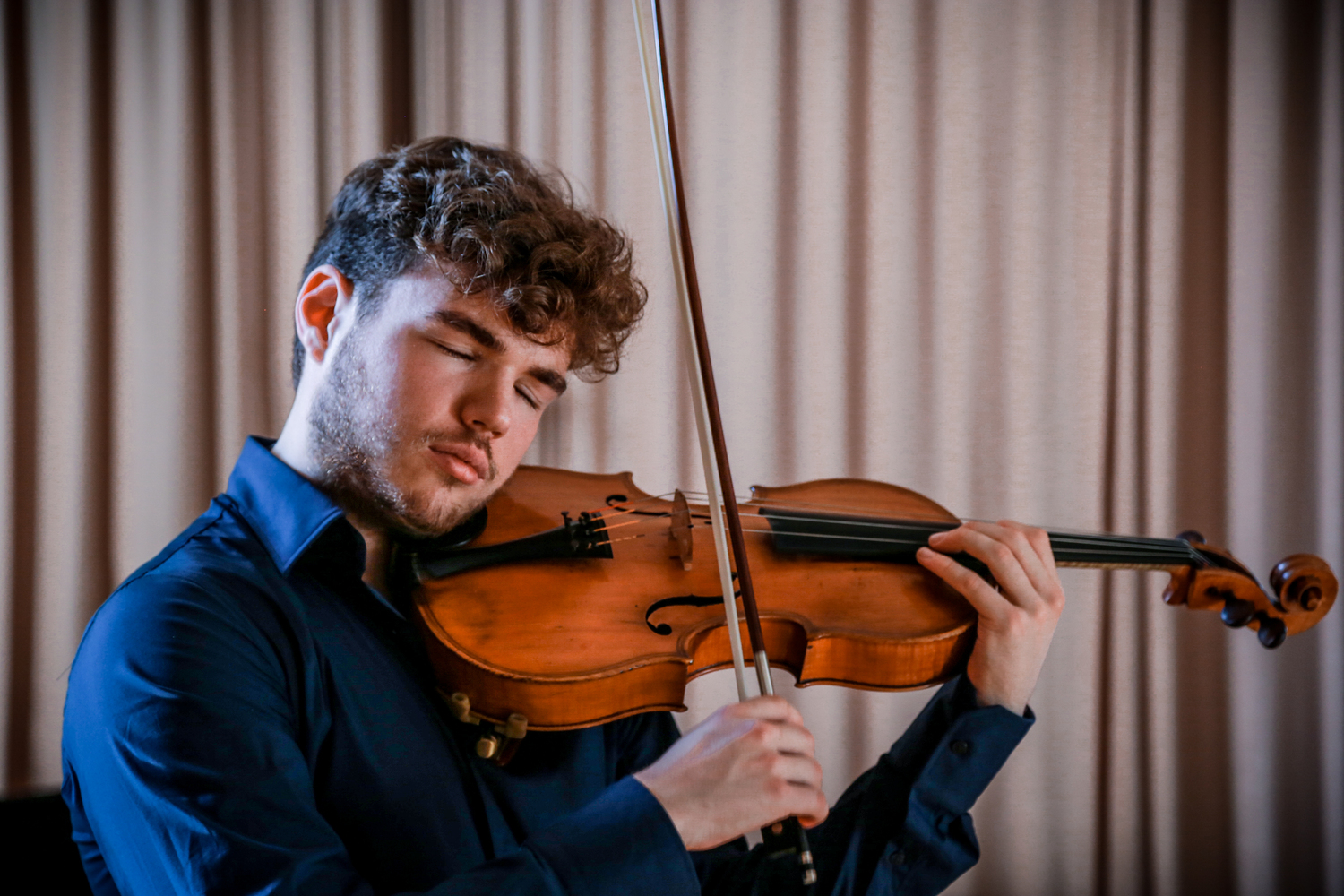Beethoven Festival Weekend, Wigmore Hall review 2 - total mastery in tone and depth | reviews, news & interviews
Beethoven Festival Weekend, Wigmore Hall review 2 - total mastery in tone and depth
Beethoven Festival Weekend, Wigmore Hall review 2 - total mastery in tone and depth
Perfect sonorities from ensembles, profundity from the peerless Elisabeth Leonskaja

Any festival would be proud and honoured to end with the great Elisabeth Leonskaja playing the last three Beethoven piano sonatas. Here the Everest was swiftly scaled as the tenth concert of a packed Wigmore Hall weekend.
Even so, I want to hear much more from Aleksandar Madžar, who wrought miraculous sounds of well-anchored clarity in the earlier concert, transforming some stock turns of phrase into something rich and rare, especially in rising from an imposing bass. In my memory, at least, he faced the indelible challenge left by Leonskaja with four peerless wind players from the Estonian Festival Orchestra at the 2018 Pärnu Festival in the Op.16 Quintet, a performance in a million, but these five - one of them sharing the two performances in common, horn-player Alec Frank-Gemmill (pictured below by Jen Owens) - shaped up very well, the individuals coming to the fore in the solos Beethoven makes sure to give oboe (Nicholas Daniel), bassoon (Amy Harman), horn and clarinet (Michael Collins) in the minor-key episodes of the superb Andante cantabile. All were taken with predictably ravishing artistry. Frank-Gemmill and Madžar turned pure artistry to creative ends in the F major Horn Sonata of 1800 - unremarkable in itself save for the short central movement, no doubt because the natural horn limited too many difficult notes (Frank-Gemmill was playing on a splendid modern instrument). The horn-player plunged in unexpectedly with a solo flourish, wittily elaborated on the repeat; the lower notes sounded richer and rounder than I've ever heard from any other player.
Frank-Gemmill and Madžar turned pure artistry to creative ends in the F major Horn Sonata of 1800 - unremarkable in itself save for the short central movement, no doubt because the natural horn limited too many difficult notes (Frank-Gemmill was playing on a splendid modern instrument). The horn-player plunged in unexpectedly with a solo flourish, wittily elaborated on the repeat; the lower notes sounded richer and rounder than I've ever heard from any other player.
By contrast the opener was high, bright and new to me: the Serenade in D for flute, violin and viola. Supremely cultured Benjamin Baker pivoted expressively, with plenty of visual life, between Janne Thomsen, Hugo Ticciati's regular flautist in the O/Modernt Ensemble, and an amazing new viola-player on the block, Timothy Ridout (pictured below), who's just become one of the latest intake of BBC Radio 3 New Generation Artists: a star to follow Lawrence Power, no doubt about that. The trio made rustic, al fresco sounds, and kicked the surprise tempest of the third-movement Allegro molto into startling life, but showed their individual sophistication in the Andante con variationi.
It was in the comparable movement of the much more famous Septet that one of the two newcomers in that second half, cellist Isang Enders, showed singing beauty of tone comparable to Baker's and Ridout's; double-bass player Jordi Carrasco Hjelm was the only one limited to support, though his sprightly underpinning shouldn't be underestimated. Again, collective and individual sonorities sounded so rich and gorgeous in the Wigmore Hall, a capricious venue acoustically speaking.  Even at close quarters, Leonskaja's colossal sound never became overbearing. Her perfect poise over the keyboard and unique spring in the relaxed hands allows her to maximise contrasts and articulation without ever drawing attention to what she's doing; there's no "here I play loud" or "here I play soft". In a sequence of movements surely even today unparalleled for difficulty and range in the sonata repertoire - eight in all, with only short pauses between sonatas as Leonskaja turned to the back wall of the platform before returning to the keyboard - no stitch was dropped, no moment left for the listener to relax concentration. You could, I suppose, showcase the Allegro molto of the central A flat major Sonata, Op. 110 - the centre of the programme, though not the heart since it was all heart and mind in fiercely concentrated equilibrium - as the epitome of Leonskaja's art, the forceful yielding to the gentler vein without a break, but just a few brief spaces for air to make sure the two didn't blur into each other.
Even at close quarters, Leonskaja's colossal sound never became overbearing. Her perfect poise over the keyboard and unique spring in the relaxed hands allows her to maximise contrasts and articulation without ever drawing attention to what she's doing; there's no "here I play loud" or "here I play soft". In a sequence of movements surely even today unparalleled for difficulty and range in the sonata repertoire - eight in all, with only short pauses between sonatas as Leonskaja turned to the back wall of the platform before returning to the keyboard - no stitch was dropped, no moment left for the listener to relax concentration. You could, I suppose, showcase the Allegro molto of the central A flat major Sonata, Op. 110 - the centre of the programme, though not the heart since it was all heart and mind in fiercely concentrated equilibrium - as the epitome of Leonskaja's art, the forceful yielding to the gentler vein without a break, but just a few brief spaces for air to make sure the two didn't blur into each other.
The greatest miracles happened, as they have to, in the finales. As Katy Hamilton pointed out in her short introduction, there's so much song here. It just happens, it just is, with Leonskaja, and the evolution of the variations is organic, too, so that you sometimes wondered how you got to the steely-radiant accents and staccatos of Op. 109's Variations 3 and 5, the furrowings of the brow in Op. 110's effortlessly-introduced fugue to banish sorrow, or the great swings and syncopations of the Arietta's most radical high-point. All of them were taken up to Olympus in three unforgettable conclusions. After a performance on this level, the listener just needs to take a break from concert-going for a bit and let it all percolate.
rating
Explore topics
Share this article
The future of Arts Journalism
You can stop theartsdesk.com closing!
We urgently need financing to survive. Our fundraising drive has thus far raised £49,000 but we need to reach £100,000 or we will be forced to close. Please contribute here: https://gofund.me/c3f6033d
And if you can forward this information to anyone who might assist, we’d be grateful.

Subscribe to theartsdesk.com
Thank you for continuing to read our work on theartsdesk.com. For unlimited access to every article in its entirety, including our archive of more than 15,000 pieces, we're asking for £5 per month or £40 per year. We feel it's a very good deal, and hope you do too.
To take a subscription now simply click here.
And if you're looking for that extra gift for a friend or family member, why not treat them to a theartsdesk.com gift subscription?
more Classical music
 Anja Mittermüller, Richard Fu, Wigmore Hall review - a glorious hall debut
The Austrian mezzo shines - at the age of 22
Anja Mittermüller, Richard Fu, Wigmore Hall review - a glorious hall debut
The Austrian mezzo shines - at the age of 22
 First Person: clarinettist Oliver Pashley on the new horizons of The Hermes Experiment's latest album
Compositions by members of this unusual quartet feature for the first time
First Person: clarinettist Oliver Pashley on the new horizons of The Hermes Experiment's latest album
Compositions by members of this unusual quartet feature for the first time
 Gesualdo Passione, Les Arts Florissants, Amala Dior Company, Barbican review - inspired collaboration excavates the music's humanity
At times it was like watching an anarchic religious procession
Gesualdo Passione, Les Arts Florissants, Amala Dior Company, Barbican review - inspired collaboration excavates the music's humanity
At times it was like watching an anarchic religious procession
 Classical CDs: Camels, concrete and cabaret
An influential American composer's 90th birthday box, plus British piano concertos and a father-and-son duo
Classical CDs: Camels, concrete and cabaret
An influential American composer's 90th birthday box, plus British piano concertos and a father-and-son duo
 Cockerham, Manchester Camerata, Sheen, Martin Harris Centre, Manchester review - re-enacting the dawn of modernism
Two UK premieres added to three miniatures from a seminal event of January 1914
Cockerham, Manchester Camerata, Sheen, Martin Harris Centre, Manchester review - re-enacting the dawn of modernism
Two UK premieres added to three miniatures from a seminal event of January 1914
 Kempf, Brno Philharmonic, Davies, Bridgewater Hall, Manchester review - European tradition meets American jazz
Bouncing Czechs enjoy their Gershwin and Brubeck alongside Janáček and Dvořák
Kempf, Brno Philharmonic, Davies, Bridgewater Hall, Manchester review - European tradition meets American jazz
Bouncing Czechs enjoy their Gershwin and Brubeck alongside Janáček and Dvořák
 Solomon, OAE, Butt, QEH review - daft Biblical whitewashing with great choruses
Even a top soprano and mezzo can’t make this Handel paean wholly convincing
Solomon, OAE, Butt, QEH review - daft Biblical whitewashing with great choruses
Even a top soprano and mezzo can’t make this Handel paean wholly convincing
 Two-Piano Gala, Kings Place review - shining constellations
London Piano Festival curators and illustrious friends entertain and enlighten
Two-Piano Gala, Kings Place review - shining constellations
London Piano Festival curators and illustrious friends entertain and enlighten
 Echo Vocal Ensemble, Latto, Union Chapel review - eclectic choral programme garlanded with dance
Beautiful singing at the heart of an imaginative and stylistically varied concert
Echo Vocal Ensemble, Latto, Union Chapel review - eclectic choral programme garlanded with dance
Beautiful singing at the heart of an imaginative and stylistically varied concert
 Scott, Irish Baroque Orchestra, Whelan, RIAM, Dublin review - towards a Mozart masterpiece
Characteristic joy and enlightenment from this team, but a valveless horn brings problems
Scott, Irish Baroque Orchestra, Whelan, RIAM, Dublin review - towards a Mozart masterpiece
Characteristic joy and enlightenment from this team, but a valveless horn brings problems
 Classical CDs: Voice flutes, flugelhorns and froth
Baroque sonatas, English orchestral music and an emotionally-charged vocal recital
Classical CDs: Voice flutes, flugelhorns and froth
Baroque sonatas, English orchestral music and an emotionally-charged vocal recital

Add comment